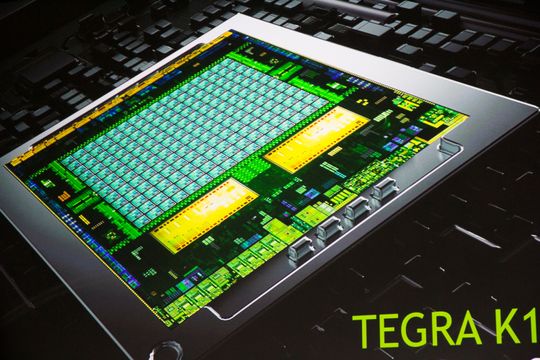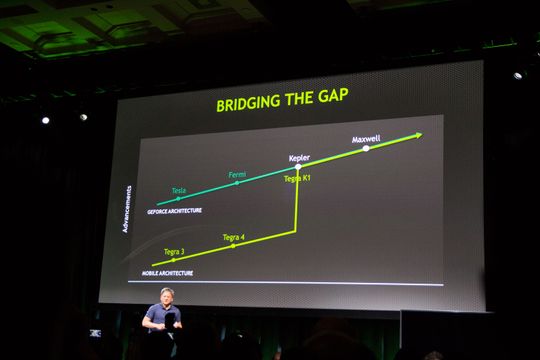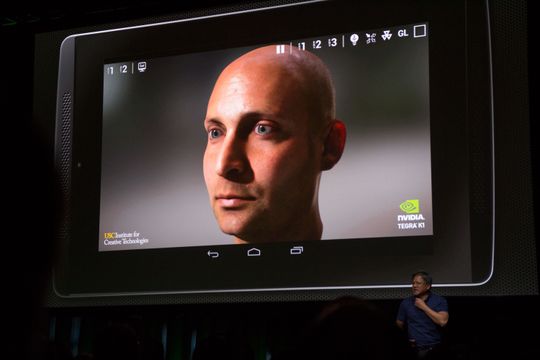– Combines the heart of GeForce and soul from Tesla.
Hardware.no / Las Vegas: At a press conference at Las Vegas’ grand Cosmopolitan Hotel in night Norwegian time Nvidia released a surprising, blazing little news: The processor Tegra K1 , with 192 onboard graphics core, and with a dobbeltkjernet variant of Denver processor as an opportunity. Tegra K1 is said to perform as well as a Playstation 3 – but with a modest power consumption of 5 watts.
Nvidia CEO Jen-Hsun Huang talked about Tegra K1 as having “heart GeForce and Tesla’s soul,” and to emphasize that it was not about a paper launch demonstrated his passing processor from the scene. The demonstration we saw was when neither of the faded variety.
– Games must be cheaper or more popular
 Nvidia Tegra K1 is based on the Kepler architecture we know GeForce Series video cards. Photo: Jørgen Elton Nilsen, Hardware.no
Nvidia Tegra K1 is based on the Kepler architecture we know GeForce Series video cards. Photo: Jørgen Elton Nilsen, Hardware.no
Top Boss started, however, not just the good stuff, but warmed including up with an immodest claim that Nvidia has done more for visual computing in the last decade than the rest of the industry overall. At the center of their focus on photorealism, programmable graphics processors, and the ability to also to be more mobile and cloud-based graphics, it is also precisely GeForce we find.
– For us start PC gaming with GeForce. That is what is the heart and soul of gaming today. GeForce make it possible to turn a PC into an impressive gaming console, and we have recently expanded this with GeForce Experience. This lets you leverage the scalability of a PC, but the simplicity of a console. It is the essence of our strategy games to come, but this is not all, said Huang.
He explained that because of all the unique challenges that game developers encounter, they will in the future be forced to either cut down on their production costs by making simpler games, or to be more popular – by finding a larger audience .
The solution may lie in Android
To address these challenges, Huang pointed to the Android operating system, which is most common on mobile phones and tablets – but in recent months has gained more foothold in the PC world.
– Android phones started in, and tumbled the market completely, before moving into the tablet, but it will not stop there. When we think of developing Tegra, we think to take Android into new markets where our expertise can make advantage. One example of a screen TVs, which goes without saying, but we also believe it is only a matter of time before Android disruptive all game console industry, said Huang.
It was with this background he asked the rhetorical question of how Nvidia would move on after already having launched mobile processors Tegra series of Android.
– GeForce heart and soul Tesla
 According to Huang, it would almost have been foul to just call Tegra K1 for a common sequel to the previous Tegra processors. Photo: Jørgen Elton Nilsen, Hardware.no
According to Huang, it would almost have been foul to just call Tegra K1 for a common sequel to the previous Tegra processors. Photo: Jørgen Elton Nilsen, Hardware.no
answer to this was thus Tegra K1, Huang called the world’s first processor with 192 cores.
– With 192 CUDA cores, we have here the first GPU that involves a colossal leap up from the previous generation. It would be almost vulgar to call the Tegra 5, because this processor is based on the Kepler architecture, the most successful graphics processor we’ve ever created, he said.
Kepler architecture is that both the newer GeForce GTX series of video games are built, and that we find in the heart of the calculation cards in Tesla series. As Huang also pointed out there are also a number of huge super computers around the world run by the Kepler architecture.
– One architecture ranges thus the processing that takes place with a few watts up to several megawatts, from 192 to millions of cores. We have brought mobile computing up to the same level as desktop and supercomputers, with the heart of GeForce and soul from Tesla.
Unreal Engine 4 will come to Tegra K1
Simply by using this new processor Nvidia would thus removing some of the differences between the more mobile and traditional game machines. This is something Huang believes will create the larger market that he believes game developers therefore will need, and Epic Games is apparently also part of this mindset.
 This image is generated in real time by a Tegra K1- processor. Notice the details that light barely shines through the ears. Photo: Jørgen Elton Nilsen, Hardware.no
This image is generated in real time by a Tegra K1- processor. Notice the details that light barely shines through the ears. Photo: Jørgen Elton Nilsen, Hardware.no – Today we can in fact tell that Epic Games will bring Unreal Engine 4, the next generation of the world’s most successful game engine, the Tegra K1. This means that the next generation of games will be able to reach out to PCs, consoles and mobile devices, with one platform and one engine, said Huang.
To demonstrate this, Huang brought a number of technology demonstrations on the big screen. He showed both cometary impacts and sparks that bounced across the floor, complete with both global lighting, reflections, particle simulation and HDR. We also demonstrated a human face, where the new Tegra processor managed to draw the light that was reflected by skin pretty impressive show.
– There are not many who would run a demonstration with a human face, because it is so difficult to achieve properly. We all know how a person looks, and we know how the skin appears. Light passes through the outer layer, reflected, and turn up some color from the blood. Light spread on the surface, is partly through his ears, and so we have the pores of the skin. But all this is possible with the Tegra K1, Huang said.
Two versions are introduced
Tegra K1 comes on the market during both a quad-core ARM Cortex-A15 variant, but in a far more surprising issue, namely that dobbeltkjernet Denver-processor, which the company has been working on for quite a while. This will be a fully dedicated processor with 64-bit ARM architecture in the bottom
It’s getting a few years since we first heard about Nvidia’s Project Denver, which was to combine a multi-core ARM processor and a GeForce graphics processor in a single chip. Since then, Denver has mostly been forgotten for most, but Nvidia has now also finally arrived in port.
Some specific launch date, we did not for Tegra K1, but Nvidia is said to have many other uses in mind than game consoles and handheld devices. Among other things, the company is heavily on integration in cars with technologies like virtual dashboard you should be able to tailor to your own taste.
Nvidia has several exciting irons in the fire, including the G-Sync »

We’re on Facebook!
- All our cases from CES 2014 can be found here »
- Follow us on Facebook »
No comments:
Post a Comment